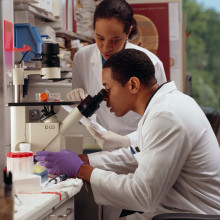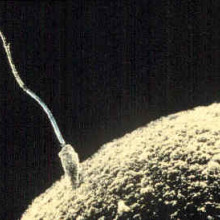Greedy labradors, a dead galaxy, and telepathic fish
In the news pod, the greedy gene fuelling hungry labradors, AI assists prostate cancer prognosis, the galaxy which died 13 billion years ago, how birds are struggling to adapt to changing seasons, and fish that send each other electrical signals to help them see farther...
In this episode

00:56 - Gluttonous labradors carry a greedy gene
Gluttonous labradors carry a greedy gene
Eleanor Raffan, University of Cambridge & Rowena Edmondson
Anyone with a labrador will probably describe their dog using one word: greedy. The breed is notorious for being a bottomless pit; but now science can write them a sick note excusing their gluttony! Because Cambridge researchers have found that a genetic change or mutation in a gene called POMC carried by many members of the breed makes them hungrier; it also makes them burn 25% fewer calories, so they’re more likely to put on weight, even with compensatory exercise. To find out more, I went walkies to meet Cambridge University’s Eleanor Raffan, black labrador Eddie who was hungrily eyeing up my microphone, and his owner, Rowena Edmondson…
Rowena - So we get up in the morning, he gets fed, and then a little bit later we go for a walk. Much of the day he will sleep. If we are eating, he'll come and look hopefully, but he knows there's not much hope.
Chris - A few obvious questions as a co-owner, an owner in common with you, there's never any food left in the bowl. Correct? True or false?
Rowena - True. The other dog's bowl gets licked clean too.
Chris - The bowl would be emptied multiple times if it were refilled?
Rowena - It would, yes. He will never leave any food.
Chris - Hello Eddie. He liked the smell of the microphone, then quite quickly realised he was not going to be able to eat it. What was the background to the study, Eleanor?
Eleanor - We knew this gene was important in how the brain controls appetite and eating behaviour and possibly energy expenditure, but we needed to test whether that was true and whether that really was what was driving the obesity we saw in affected dogs.
Chris - So you put out a call for people with hungry dogs?
Eleanor - Very specifically we didn't actually, what we did was put out a call for people with Labradors and we made no reference at all to whether they were hungry or overweight. In fact, what we did was recruit dogs like Eddie who've been slim throughout their lives.
Chris - How did you test dogs like Eddie?
Eleanor - They all came into our research area in Cambridge and we tested their eating behaviour in a couple of different ways and also their energy expenditure, what their metabolic rate was doing and how many calories they were burning up during their day-to-day lives.
Chris - And then married that up to their DNA profile?
Eleanor - Exactly. And we took slobber samples to get DNA from them all.
Chris - How did you appraise dogs like Eddie's eating behaviors, then?
Eleanor - We tested what we call satiety, the point at which you feel full after a meal, by offering these guys cans of dog food every 20 minutes until they stopped eating. And it turns out that labradors will stop eating in the end, but usually not until around the two kilogram mark, which is an awful lot of food.
Chris - It is an awful lot of food. But that presumably tells you that it's not that they can just accommodate massive great meals that makes them hungry all the time. They will stop. So therefore it has to be a sort of fullness.
Eleanor - Exactly that, and so many people came in and said, 'My dog's never going to stop eating.' But it turns out they do, and that reflects the fact that there are pathways in the body that say, no, that's enough. But the third thing we looked at was hunger. We did that using something we call the sausage in a box test. We showed these guys a sausage and put it in a plastic box that was clear so they could see through it and they could smell it because it had holes in the lid. Then, we videoed what they did, and when we did that we found that dogs like Eddie who had the mutation we were studying were far more attentive to the sausage in the box and paid so much more attention to it and got so much more excited compared to the dogs without the mutation.
Chris - And what about the point you made about burning more energy off? Are they really hungry all the time because they're just getting through huge numbers of calories or are they just greedy?
Eleanor - The other part of our study was to look not just at the amount of energy they might be getting in from their food, but also how much energy they were burning off in maintaining their body's functions. We were astonished by the results which say that dogs like Eddie, who have two copies of the mutation, burn off about a quarter fewer calories every day.
Chris - Tell us about the gene, then: what it does and how it's doing that to dogs like Eddie.
Eleanor - So POMC is a gene that we've long studied as having a role in how the brain controls body weight. It makes sense to have some energy reserves in the body in case there's a period where there's nothing to eat, and so the body has a system to get an appropriate amount of fat mass, and POMC is integral to that system by acting in the brain to dial up and down hunger and energy expenditure. What this mutation is essentially doing is sending the dog's body a starvation signal and the body is responding very sensibly by increasing food intake and also by dialling down how much energy they're burning off to keep the body running. If they really were starving, that would be a very sensible thing to do but, because it's due to a mutation and actually they've got plenty of food, it will tend to make them put on weight if they're given a chance.
Chris - And is that because we've bred them to have a certain set of traits? We've inadvertently bred that in?
Eleanor - Possibly. I'm slightly reluctant to answer this question. In our original study, we had this really intriguing finding that the mutation was more common in guide dogs than it was in pet dogs. That leads to this very tantalising, very tempting hypothesis that maybe we have inadvertently bred our high performing dogs to be a bit foodier because, if you are foodie, you'll do anything for a biscuit and it makes you a bit more trainable. I have tried to test that scientifically and I can't prove it yet. I'm a little bit cautious about talking too much about it, but I think that may still have legs as a hypothesis and may still be true.
Chris - When you tested Eddie, we've heard that he likes his food, what did you find genetically? Where does he sit on this spectrum?
Eleanor - Eddie has two copies of our mutation, so he's at the worse end, he's got a double dose of this. Of course it matters what's in his other genes as well and we have by no means explained why all labradors are greedy. We've just got a bit of it in a quarter of them and we are working very hard on what the other things that are important are too.
Chris - Were you pleased, Rowena, to have an answer to why Eddie is a slave to food?
Rowena - Yes, it's nice to have an explanation, but it didn't really change my behaviour towards him.

07:17 - AI tool helps avoid unnecessary prostate cancer treatment
AI tool helps avoid unnecessary prostate cancer treatment
Dan Woodcock, University of Oxford
More than 50,000 cases of prostate cancer are diagnosed in the UK every year. It’s second only to lung cancer as the leading cause of cancer mortality in men.
But most men diagnosed with the disease will die with it, rather than from it. Which means the quandary confronting patients when they receive a prostate cancer diagnosis at the moment is whether or not to aggressively treat the disease and run the risk of unnecessarily suffering a range of life-changing and serious side effects.
But now a new AI-based approach has helped scientists at Oxford University to unpick the genetic changes that occur in a tumour as prostate cancer develops, and identify a set of changes that single out cancers that are destined to be more aggressive.
This could help doctors provide much better advice to patients around how to manage their disease. I’ve been speaking to the lead researcher Dan Woodcock…
Dan - The current standard of care involves taking a biopsy and then performing a grading. So a pathologist looked down a microscope at what the cells look like, then assigned it a grade, and that grade is really good at identifying very high risk patients and very low risk patients. But the intermediate risk category, that doesn't really supply very much information on.
Chris - And I presume that most people probably do fall into that intermediate category then?
Dan - That's correct.
Chris - So we've got basically a big problem making accurate prognostications for people who want to know, do I really go for it and get this treated aggressively or can I afford to take this a bit more slowly?
Dan - Yeah, that's right. People with cancer often obviously err on the side of caution and opt for that treatment, which they may well not need.
Chris - So how have you approached this then? How have you tried to get at that middle ground?
Dan - Cancers don't really happen overnight. They start off as a normal cell, then genetic alteration, DNA mutation, will occur over time. More and more mutations will accumulate in that cell and then it'll go malignant and then it'll start growing uncontrollably and ultimately it will metastasise and then kill the patient. So we took DNA sequences from over 150 patients, tried to evaluate which mutations were in those patients at all these different stages, and then put that information back together and that basically gave us a better understanding of how the tumour evolves and what might distinguish aggressive disease or high risk disease from the more low risk ones.
Chris - The human body's got thousands of genes in it, though. So how do you look at all those moving parts all at once to try and spot the pattern as to what is evolving into what?
Dan - Well, we developed a kind of AI algorithm able to identify patterns of genetic alterations that are actually linked with the progression of the disease and ultimately the outcome.
Chris - Ah, so you can use AI to spot what's changing when, consistently?
Dan - Yep, that's right. So we use the type of interpretable AI so we can gain the information back from the computer about what's going on at the genetic level, and then use that information to further our study.
Chris - And what did your AI tell you?
Dan - The AI revealed there was two different routes of progression. One of these routes is a standard route of prostate cancer development, it's relatively slow growing, and after a number of years, perhaps decades, the cancer will get to a stage where it will metastasise and become a more dangerous form of the disease. What we also found is that there's an alternative evolutionary route, more like a fast track for more aggressive disease, so it reached the aggressive state a lot quicker. If you think of it like being stuck in a traffic jam on a motorway, you're very slow going, the motorway is full of traffic, but then you can see, okay, I can take this route off here, go through some of the side lanes and get to my destination much faster.
Chris - And so presumably if you know what those side roads are that take you on the fast track to a tumour, you could then apply that to, if you've got a biopsy from a patient, and say, well, is someone showing signs that they're on those side roads, therefore their disease is likely to become aggressive more quickly? And that would be useful to the patient because they'd know to go in and treat that disease more aggressively?
Dan - Yes, that's exactly right. So what the interpretable AI showed us was the features of those side roads, really, so what routes those side roads can occupy and what DNA mutations characterise those side roads. And then you're absolutely right, we can use that knowledge to then extrapolate what individual tumours patients have and then tell them what type of disease, what road they're going down, and then give them a better treatment outcome.
Chris - I was going to ask you, if you've now got almost like the map of what those side streets that take people to a more aggressive cancer are, does this mean you can put roadblocks on them? Does this show you possible therapeutic avenues to block those pathways in different ways or in better ways than we do already, or even that we can do already but we just don't think to use them in certain patients, so that we can optimise someone's care?
Dan - Yes, it does. So in patients where prostate cancer's already metastasised, so spread to other organs, we use something called hormone blockade to slow down the progress of that disease. The tumours like taking the fast track, they've already learned a different way to process these hormones. It makes sense that by using hormone blockade it will actually be even more effective on those tumours and that's something that we're looking into.

13:25 - Birds finding it hard to adjust to shifting springtime
Birds finding it hard to adjust to shifting springtime
Ellen Robertson and Scott Loss, Oklahoma State University
But first, a new study suggests that the times at which plants start to display their green shoots are shifting - but bird migration in the spring is not adjusting accordingly. So, what’s going on, and what might the consequences be? I’ve been speaking to Oklahoma State University’s Ellen Robertson and Scott Loss…
Scott - The climate is changing worldwide and one of the big things happening is the changing of the seasons. One of the patterns that we're seeing is the earlier arrival of spring and with that earlier leaf out and flowering out of trees and the associated food resources that accompany that. Our question was to really delve into the degree to which migratory birds are tracking or not tracking that change in the timing of spring. There's a lot of concern about are birds gonna be able to time their migrations to track the changing timing of spring or are they gonna increasingly be disconnected from that with potential implications for their populations and persistence?
Chris - And how did you get at that question Ellen?
Ellen - We were able to use a gigantic citizen science database from eBird that was collected by volunteer birders from all across the western hemisphere over a 20 year period. We connected that to data from satellites up in space that are collecting data on vegetation greenness on the ground to understand how climate change is affecting bird migration.
Chris - So presumably the bird watcher data gives you a time and a place and a species when different things arrive in different places and when. And the satellite data tells you what nature's doing in the geographies that these animals are coming to. So you can look at whether there is joined up migration or disconnect beginning to emerge.
Ellen - Right, exactly. And we did this for 150 bird species and so this just shows the power of community science and all of these people collecting this data combined with this enormous satellite data that's being collected from space.
Chris - Scott, can you give us a sort of high level overview as it were of what emerged from this? So first of all, what did nature do differently across the 20 years of the study in terms of the arrival times of spring? Was there a genuine trend there that shows spring coming earlier?
Scott - So there's variation from year to year in terms of the arrival of spring, but really at a large scale and across the 20 years of data that Ellen looked at, there's still a consistent signal for spring happening earlier.
Chris - When you say it's coming earlier, how much earlier? Are we talking a few days adrift or is it things are beginning to move maybe a month or so, something significant like that?
Ellen - There is a lot of variation but it looks like from the maps of this year so far, a lot of the United States is 10 to 15 days earlier than long term averages.
Chris - And what about the birds? What do they do?
Scott - One of the major questions with this research was the degree to which migrating birds in spring can track the changing green-up pattern that we're seeing with spring coming earlier. And this is the first study to really address that specific question across numerous bird species and 110 or so of the 150 species are more closely tied into the long-term averages of greenup, which suggests that their migrations are more static and consistent towards past springs, not the current springs that they're experiencing. And there's also evidence that that earlier spring green-up is increasing the gap or contributing to an increasing gap between the timing of green-up and the timing of bird migration, especially birds that migrate very long distances, uh, wintering in places like the Caribbean, central and South America and come to the us, Canada, et cetera, to spend the summer. Those species are the least flexible it looks like.
Chris - I suppose the problem for them, Ellen, is that when they depart from wherever they've spent the winter, they've no idea what the weather is doing and therefore what spring is doing in their target destination till they get there. And by the time they do, sometimes it's too late.
Ellen - Exactly. That's thought to be a problem of migration. Very complicated. Birds use magnetic fields, stars, the sun, different landforms on the ground in terms of the long distance migrants. There's some evidence that they're more triggered by things like day lengths and things that don't vary and so they may be less flexible as conditions are changing along their migration roots
Chris - Is the reason this is such a problem for these migrating species that if they arrive and they want to have babies, then spring is already sprung and various insects and things that they would rely on to feed their babies, those presumably have like a caterpillar, have now become butterflies and they're no longer a potential food source. Is that the problem?
Ellen - Yes, that definitely is a huge issue. And there is some evidence that there are these demographic mismatches occurring with birds when they're breeding, that it is having some consequences for their fecundity when either spring is very early relative to normal or very late, they're not as matched and so they're not reproducing as well.
Chris - And so Scott, is there evidence this is being reflected in declining populations of birds, for example, are the birds clearly being impacted by this or do they appear to be able to tolerate it, albeit that the conditions are less ideal for them?
Scott - That is the big question, what do these, the increasing gaps between the timing of migration and the timing of spring and spring green op, mean for bird population? Persistence? There are suggestions that if you are missing your key resources during migration, there could be some implications to you during migration. Your physiological condition and health during migration might be affected. That can affect your ability to complete migration, let alone make it to the breeding ground and reproduce. Birds are in decline worldwide. There was a well-known paper in the US a few years back ago showing that we've lost about a third of our birds over the last 50 or so years. And there's a whole host of reasons for that, like habitat loss, chemical use, um, invasive species, et cetera. Climate change and associated disturbances with that has to be a part of it as well. But figuring how these types of climate change related disturbances play into those declines is an open area of inquiry.

20:04 - 'Dead' galaxy stopped forming stars 13 billion years ago
'Dead' galaxy stopped forming stars 13 billion years ago
Francesco D'Eugenio, University of Cambridge
With the help of the James Webb Space telescope, astronomers have spotted a galaxy that suddenly stopped forming new stars more than 13 billion years ago. The ‘dead’ galaxy was just 700 million years old - which makes it the oldest such galaxy ever observed. To find out more, I went to meet Dr Francesco D’Eugenio from the Kavli Institute for Cosmology at the University of Cambridge…
Francesco - So the universe was born from the Big Bang, and then it started as a uniform distribution of gas. But if we look out today, the universe is made of galaxies. It's mostly empty and is dotted with galaxies. So understanding how it went from this uniform fireball of gas to what it is today is one of the main tasks that we're trying to understand in contemporary astrophysics.
Chris - How can you see back in time in that way then? Because what you are saying is, 'I want to get a glimpse back to not long after the universe formed to see how that very homogeneous smooth thing became aggregates of material that is going to be segregated into galaxies.' But that was millions, billions of years ago.
Francesco - Exactly. So the key here is that the speed of light is very, very high, but it's finite and it's this that permits us to look back in time. The light that we see from the sun now left the surface of the sun about five minutes ago. So when we look at the sun, it's as if it was five minutes ago and, as for the closest star, we see it now as it was four years ago. So the earliest galaxies enable us to see how the universe looked sometime after the Big Bang. The most distant galaxy, we can see it as it was 300 million years after the Big Bang. Of course, the galaxy now is completely different.
Chris - How can you interrogate the information coming to us from 13 billion years ago to understand what the structure and the dynamics of that very early galaxy would've been then.
Francesco - The key information here is that those galaxies are made of the same matter and obey the same laws of physics that are observed in the local universe. So for example, we can look at signatures of chemical elements and the colour of the light emitted by these chemical elements which tell us about how distant the galaxy is and also tells us the intensity of these various colours. If it's bluer or redder, let's say, for particular elements, that tell us about the chemical abundances and also the physical processes actually that excite this light.
Chris - I get it. So you're almost doing a molecular postmortem on what that galaxy looked like, what the stars in it were making, what they were made of, the abundance of different chemicals. You can tell all that even though it was 13 billion years ago and the universe wasn't very old.
Francesco - Exactly.
Chris - You must presumably then have started with an idea or a theory about what you thought the universe and its galaxies looked like at that time point. And then, now you've actually got one that old and got this data, you can ask, is it different from our theory and if so, how different and why might that be? Is that the direction you took?
Francesco - So we expected, for example, that most if not all galaxies will actively start forming in what we call a starburst; so very, very high rate of formation of stars. We're talking about tens or hundreds of new suns per year in those galaxies. But instead we found that some of these galaxies have stopped forming stars, and this is remarkable because in this epoch, the universe is replete with gas. There is a gas abundance and this is the fuel for star formation, so galaxies are the ideal place to compress this gas and start forming stars. So in some way it's akin to seeing a smoker in a sea of petrol and nothing is happening. We don't know if something removes the fuel so that's why there's nothing burning or if for some reason the fuel refuses to catch fire.
Chris - Do you know if it's the rule or the exception?
Francesco - So far we think it's the exception. We have only found one target, one galaxy that has this particular property. This one is probably the most beautiful example but we recently got awarded more time to look for similar targets to confirm and understand exactly what their incidents are. In astrophysics, what we try to do is to understand time dependent processes, but only having a snapshot frozen in time if you want, it's like trying to understand human life from a picture of the whole world. So the number of this galaxy will tell us, for example, how often this occurs and therefore what are the likely physical processes that can power it, how fast this occurs. And so this can tell us, for example, if it's due to energy released by matter, falling onto super massive black holes.
Chris - Doesn't it blow your mind a bit though, even though you are an expert in the subject, to think that you are seeing something from so soon after the whole universe began to exist? It really makes me feel a bit of shivers down my spine when you start to have conversations like we're having.
Francesco - It is indeed very, very, I think, humbling to think how big the universe is and how small we are. And I think that puts it in perspective a bit our life and that our common history started so long ago, the elements we are made of, we as in our bodies are made of, for example, blood in our veins contains iron that was made inside stars and then circulated in the galaxy, ended up on this planet and finally in our bodies. So our story in some sense our common history started so long ago.

26:08 - Fish exchange electrical signals to extend their eyesight
Fish exchange electrical signals to extend their eyesight
Nathaniel Sawtell, Columbia University
Some fish, it turns out, can “beam” sensory information to other nearby fish to extend their detection range. Working with African electric fish - also known as elephantnose fish, the team, at Columbia University, have found that the animals use electrical receptors on their body to detect external signals as electric images that they then share with among themselves, allowing them to see objects as a group and much farther than they could manage alone. Sannia Farrukh heard from the study lead, Nathaniel Sawtell…
Nathaniel - We built a computer model of the electric fish and its field, and then we could place objects and other fish in different configurations and then look at the electrical images on the skin of the fish. So we could use the model to calculate or visualise how the electrical field of the fish interacts with objects. And we could do this under conditions when the fish was all by itself or when it was in a group. And what we saw from these simulations is that when the fish are in groups, they actually can potentially gain a great deal more information about their environment. And in particular, what we were intrigued by is that in groups, the fish can actually see further away. So an object that would be outside of the range of electro location for the fish when it was on its own, was actually clearly visible to the fish when another nearby fish was also emitting electrical pulses.
Nathaniel - So this idea that came out of this was that the electric fish could amplify their electric sensing in groups. So we saw this first in the model, and then indeed what we were able to see in the brain is that when two fish were nearby each other, we saw electrical signals in the brain of the fish or neural signals in the brain of the fish related not only to the fish's own pulse, but to the pulse of the nearby fish. So when the fish were on their own, we saw this very limited range. But when we added electrical pulses into the water, simulating those from other fish, we saw that the sensing range was dramatically enhanced. So it increased by a factor of two or even factor of three in some cases.
Sannia - I've seen this dubbed as telepathy. Is that a fair comparison or is it more a case of group electric effect? Like how swarms of bees create a much larger electrical charge?
Nathaniel - It's certainly invisible to us. So these electrical fields are emitted by the fish. We can't see them, we can't feel them. They travel at the speed of light. So they certainly have magical qualities, but they're electrical fields, just the same kind of fields, you know, that we deal with when we turn on the light switch. But it is remarkable in that way that the fish are emitting this energy into the water and then the other animals nearby all benefit from that energy. That energy conveys information to the entire group at virtually the same instant.
Sannia - So do you think there could be other species with such abilities?
Nathaniel - In terms of other active sensing animals? The ones that are studied the most are bats and dolphins, both of which use echolocation to sense their environment. Researchers that study those animals have speculated and wondered about these same issues. What happens when bats are in a group or dolphins are in a pod? Are the emissions of the other animals a source of interference or could they help? There's some evidence in those systems that jamming could be a problem. There's a little bit of evidence that the animals could actually sense as a group. So it's something that needs to be investigated more. And we think our studies showing that the electric fish can sense as a group could motivate more studies of these other animals.
Sannia - So what are the next steps of this study? Are you going to look at the neural mechanism?
Nathaniel - We're very interested in the neural mechanism, certainly. And it's, you know, it's worth noting that these fish that we're studying have enormous brains. So they have larger brain to body mass ratios than humans actually. And their brain has evolved in a very interesting peculiar way. The large brains of humans are dominated by the cerebral cortex, which is grown to cover the entire brain in these fish, a different part of the brain. The cerebellum is the dominant part of the brain that covers the entire surface of the brain and makes it so large. So we've often wondered what kind of intelligence these animals have that relies on the cerebellum. In particular, one possibility that this work suggests is that these animals use the cerebellum to make sense of this information that they're receiving in groups. And one thing you could imagine is that in order to sense in a group, you have to have very good knowledge of your group members.
Nathaniel - And you might even need to predict how they're moving in space and keep track of that. And again, since these fish are doing all of this in dark, murky rivers without the benefit of much vision, you'd have to have some pretty sophisticated abilities to be able to keep track of fish in a group. And then all these studies, of course, were done in the laboratory setting and fairly reduced settings. So we were very curious about what are the real ecological functions of this group sensing in the natural habitats of these animals? Do the fish really actively change their behaviour? Do they position themselves in a way that makes this sensing work better? Do they coordinate the timing of their pulses? So the degree of social coordination and cooperation is another fascinating open question that we'll follow up on.

Do we ever run out of sperm?
Will Tingle asked developmental endocrinologst Professor Rod Mitchell of the Univeristy of Edinburgh if he could help with the answer...
Rod - The answer is no. New sperm are being produced all the time from stem cells in the testicle, and this happens throughout adult life. Although sperm counts do decline with age, as long as there are stem cells in the testicle, then sperm will never run out.
Will - A reassuring start, but in what situation would one's amount of sperm decrease?
Rod - If those stem cells are damaged or lost, for example, with some forms of cancer treatment, then sperm production may not recover. This situation in men with continuous sperm production throughout adulthood is in contrast to the situation in women who are born with all their eggs, which are gradually lost over time until menopause when there are no functional eggs left.










Comments
Add a comment